
Zero Discharge System
Material : Stainless Steel

Water Softening Plant
Water Sciences' softening plant is charged with strong acidic cation exchange resin in sodium form. Raw water flows upwards through the resin bed. The calcium & magnesium which forms hardness in water are exchanged for sodium which is non-hardness forming. When it has exchanged all of its sodium for Calcium & Magnesium, the ion exchange resin is regenerated. The solution of common salt- Sodium Chloride is passes to the resin bed with brine ejector. The softening plant is thoroughly rinsed with water to remove excess salt. The softening plant is put back to service after getting commercial zero ppm water hardness at outlet. Applications Boiler feed, cooling tower makeup, Induction Furnace cooling system, Beverage mfg, Pre treatment in RO plant, Textile Processing, Hospital, Hotel, Laundry, Air conditioning plant & Housing society for softening of Bore well water. Scope Of Supply Water Sciences’s softening plant is supplied as a pressure vessel constructed of welded mild steel & provided with top & bottom flange covers. Supports. Water distribution by top & bottom plates of heavy duty polypropylene strainers. The vessel is externally painted with coat of red oxide & internally with anti corrosive epoxy, paint. The unit is complete with resin brine ejector brine tank, sampling tap pressure gauge, frontal piping diaphragm valves and a hardness kit. ADVANTAGES Low cost of regeneration , compact easy to install & operate. Consistent soft water quality and negligible maintenance. The special diaphragm valves with in-out stem indicator make task of handling multiple valves easy.
Weight : 1000-2000kg
Voltage : 220V
Automatic Grade : Automatic
Power : 1-3kw
Driven Type : Electric
Warranty : 2years
Type : Water Softening Plant
...more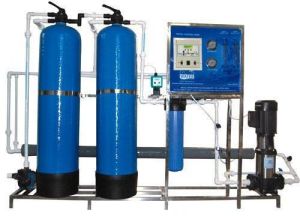
Water Purification Plant
Material : Stainless Steel

Water Demineralisation Plant
Thousands of users of laboratories, factories and workshop throughout the world have found that Water Demineralisers plant is economical and the simplest way to produce distilled quality water almost free dissolved solids. Water Sciences'D emineralisers are up flow two bed/ mix bed type. Compact and simple to operate with conductivity meter to monitor quality of treated water continuously when in operation. Water Sciences, Demineralisers are available in different models to suit any of your requirement. Two Bed Up-flow Demineraliser Plant Water free from minerals is called demineralised water. Water contains many minerals salts in dissolved form which is called dissolved solids. To remove salts from water, it is treated with cation and Anoin resin coloum. The raw water is passed through cation resin coloum (H+ form) which converts an ionized salts to equivalent acids, now the acidic water is passed through Anion coloum (OH form) which absorbs acids and water available is Dimineralised water When the resins are exhusted the cation resin coloum is regenerated with HCI and Anion Resin coloum with NaOH solution. After regeneration now the plant will be in position to give deionised water up to next regeneration. Mix Bed Demineraliser Plant Water Sciences's Mic bed Demineralisers are single coloum unit in which cation and anion charged resins are in mix bed condition. Water passing through this unit will thus come in contact with numerous deminralising stages. Thus no dissolved solids can escape through mix bed coloums. By this method exterminate pure water can be obtained. For regeneration resins are separated by back-washing the cation resin is regenerated with acid and anion with alkali. After rinsing the resins are mixed again with compressed air. Details Two bed Demineraliser - Two FRP/MS rubber coated coloum charge with corrosion resistance material fittings for containing cation : One Degasser tower to remove dissolved gases. Mix bed Demineraliser - One FRP Coloum with cprrosion resitance material fittings for containing cation and anion exchange resin Optional: One motor driven air blower of adequate Capacity for remixing resin.
Weight : 2000-3000kg
Power : 3-6kw
Warranty : 2yrs
Sterilizing Rating : 99.99%
...more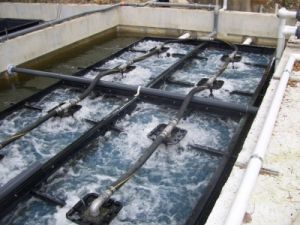
Wastewater Recycling Plant
Application : Treatment
Weight : 1000-2000kg
Voltage : 220V
Automatic Grade : Automatic
Power : 3-6kw
Warranty : 2years
...more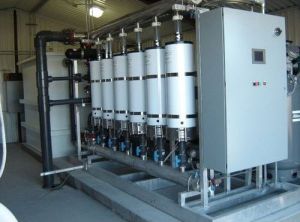
Ultrafiltration Water Treatment Plant
Type : Water Purification for Drinking
Voltage : 440 V

Swimming Pool Filtration Plant
Weight : 2000-3000kg
Power : 3-6kw
Driven Type : Hydraulic
Warranty : 2years
...more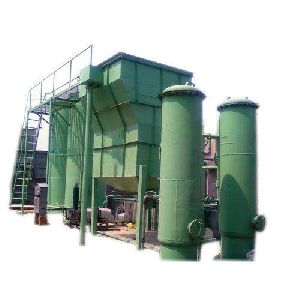
Stp Plant
Industry : Pharmaceutical Industry
Capacity : 500 m3/day
Material : Carbon Steel
...more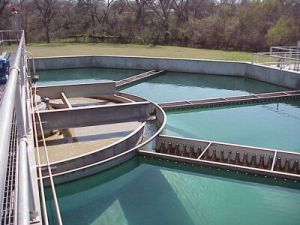
Sewage Water Treatment Plant
Water Sciences' ,conceptualize, design, engineering and implements STP projects. Sewage treatment is process of removing contamination from household sewage. It includes physical, chemical and biological process to remove contaminants and produce environmentally safe treated wastewater. A by- product of sewage treatment is usually a semi solid waste or slurry called sewage sludge that has further treatment before being suitable for disposal on land applications. Activated Sludge Process The power of microbs to digest organic matter Water Sciences' treats sewage water by conventional activated sludge process. The treated water meets the standards of state pollution control board and can be used for agriculture/ horticulture purpose & toilet flushing. Activated sludge process is based on the principle that adequate maount of oxygen is passed through sewage containing microbes. Complate aerobic oxidation occurs, though slowly. However, if this aeration is carried out in presence of a part of sludge form previous oxidation process, the oxidation process is much quickened. this so added sludge form the previous process is known as activated sludge, sludge, since it contains organic matter inhibitated by numerous bacteria, etcs. The process consist of mixing the sedimented sewage with proper quantity of activated sludge and the mixture is then send to the aeration tank, in which the mixed liquor is simultaneously areated and agitated for hours. During this process, oxidation of the suspended organic matter takes place. First, oxidation of carbon takes place, followed by that of nitrogen to nitrates and nitrites. after aeration, the effluent is sent to clarifier tank, where sludge is deposited, clean and non purifying liquid (practically free form bacteria, etc.) is drawn off. A part of the settled sludge is sent back for setted fresh batch of sewage. while the reminder's disposed off by spreading uniformly over pebbles and gravel beds (sludge drying beds) for drying in open atmosphere. This dried sludge is called a sludge cake, Dried sludge cake' is usually spread on fields, returning organic matter and nutrients to the soil. Form the clarifier tank water shall be collected in to chlorine contact tank where hypo-chlorite is dosed for the removal of disease-causing organisms. The disinfected water is then fed to sand and activated carbon filter for the removal of residual suspended solids, chlorine & BOD/COD before discharging the wastewater for final disposal. Diffused Aeration A revolutionary technique for waste water treatment In the waster treamtment process. Aeration is to be effective must transfer oxygen to the liquid for use by microorganisms to product a floc and mixing the liquor, diffused areation is effective method for areation by means of porous diffusers installed at the bottom of the tank in the areation process, oxygen transfer tanks place by molecular diffusion through the interface film between air and liquid and it increases in proportion to the interface area for a given air flow, as the number of bubbles increase, the surface area increases and the rise velocity of bubbles decreases the diffused areation transfer more oxygen to the liquid than mechanical areation.
Weight : 2000-3000kg
Voltage : 220V
Automatic Grade : Automatic
Power : 15-20kw
Warranty : 2years
...more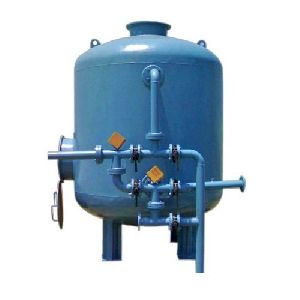
Sand Filters
Vessel Diameter : 200-400 mm
Vessel Height : 800-1000 mm

Reverse Osmosis Plant
When two aqueous solutions of different concentrations are separated by a semipermeable membrane, naturally occurring osmotic pressure forces dilute solutions into the concentrate solutions this natural phenomena is called osmosis which continuous until equilibrium between the two solution is reached. The flow's natural direction can be reversed by applying pressure greater then osmosis pressure to the concentrated solutions. This process of reversal of solvent flow known as "Reverse Osmosis" (RO). Application Drinking Water, Ice Cube Making, Pharmaceutical, Food & Beverage, Bulk Drugs, Hemodialysis, Electronics, Bio Medical Application, Cosmetics, Laboratory Applications, Printing Presses, Boiler Feed....
Material : Metal
Finishing : Polished
Power : 1-3kw
Driven Type : Electric, Hydraulic
...more
Multiple Effect Evaporator
Material : MS Sheet
Voltage : 220 V also in 380 V
Automatic Grade : Automatic
Power Source : Electric
...more
Membrane Bioreactor
Automatic Grade : Automatic, Semi-Automatic, Manual
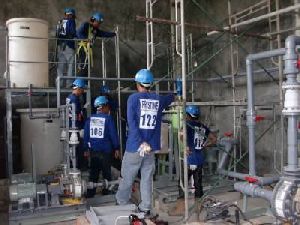
Effluent Treatment Plant
Leveraging on the talent and knowledge of our professionals,we are into providing a precisely engineered array of Effluent Treatment Plant. This Effluent Treatment Plant Is helpful in treating and purifying the wastewater in efficient and perfect manner. This product is used for treating water to make it suitable for various purposes. The Industrial Effluent Treatment Plant offered by us is easy to use and known for their effective usage. High PERFORMANCE Excellent OUTPUT Easy OPERATE Well equipped with all the Latest features Prolonged Durability & Reliability
Weight : 2000-3000kg
Voltage : 220V
Automatic Grade : Automatic
Power : 15-20kw
Warranty : 2years
...more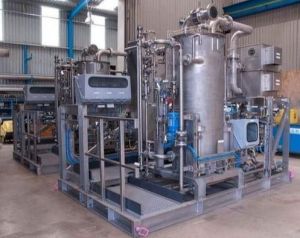
Chlorination System
Input Voltage : 220V
Material : Mild Steel
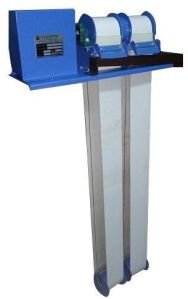
Belt Oil Skimmer
Material : Steel

House Water Testing Laboratory
Be first to Rate
Rate ThisOpening Hours